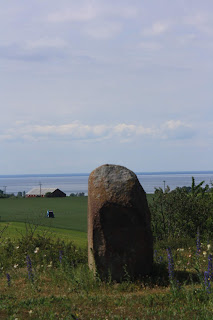We don't tend to use the moho for day trips. It's a pain to find parking spots more often than not. Much better to use it as base and visit places in the vicinity by bike or use public transport. However, today we planned to drive to the places we wished to see in South Öland with fingers crossed that we would be able to park our favourite heap of metal nearby.
First stop - Ölands södra udda, the island's southern most point, with a big lighthouse, 'Lange Jan'. No problem parking here, there was even another British Bürstner, I surmise it belonged to the chap in the North Face tee shirt, I did give him a smile and nod, maybe he did not notice, but no response.
We decided against climbing to the top of the lighthouse instead we walked to the end off the promontory, well as far as the single strand of wire separating humans from the seabirds and seals on the rocks beyond. We could hear the seals barking, but couldn't see them. Looking into the sun the black blotches out to sea could have been the heads of seals, or the tops of rocks, tricky to say.
The whole area is a bird sanctuary, so many a twitcher to be spotted too, dressed in khakis, half folded tripod in hand with big telephoto on posh camera, or spotting scope. Why do the males of the species always bear an uncanny resemblance to Harold Shipman?
The whole area is a bird sanctuary, so many a twitcher to be spotted too, dressed in khakis, half folded tripod in hand with big telephoto on posh camera, or spotting scope. Why do the males of the species always bear an uncanny resemblance to Harold Shipman?
Next stop - Kart X Gustats mur. A Swedish tourism site describes it thus:
"The somewhat strange-looking structure was built in 1653 at the behest of King Karl X Gustaf, to separate the grounds of the royal estate Ottenby on the southern tip of Öland from the rest of the island."
It has to be said Karl X's wall is very fine, arrow straight across the island. It was entirely ineffective at keeping the deer within the royal estate; they simply swam around the edges. What is it with power crazed despots and wall building?
Now we headed up the main road towards the Gettlinge grave fields. More from the online tourism guide:
"The entire burial site once consisted of about 250 graves, most of them were typical Bronze and Iron Age tumuli. 15 of the over 200 remaining graves have been examined archaeologically. The studies have noted a use of the grave field over a period of about 2,000 years - from about 1000 BC. to 1050 AD.
What the bald facts fail to capture is the beauty of the place. It is next to the main road, but it has barely any traffic. Most of the time we had the entire site to ourselves.
It occupies a rare scrap of higher ground, one of the few places where you can see right across the island from coast to coast. The ground among the ancient stones was covered in wild flowers.
As well as the standing stones the area has a few examples of the miniature windmills that Öland is famous for. Unusually farmers milled their own grain here rather than using a communal facility. The little windmills were movable. If a tenant farmer changed his holding he took the windmill with him.
As well as the standing stones the area has a few examples of the miniature windmills that Öland is famous for. Unusually farmers milled their own grain here rather than using a communal facility. The little windmills were movable. If a tenant farmer changed his holding he took the windmill with him.
Our final destination -the Karlevi Runestone. It was tricky to find, the final few hundred metres down a close hedged single track lane. The only way to deal with oncoming traffic would have been to reverse back to the main road. We were lucky.
The tourist map described the monument as follows:
"The islands oldest Runestone from the 10th century tells the tale of a Danish sea hero who was buried in Öland's soil."
It feels like a very special thing, magical almost. It was carved, AD1000, a moment of transition in Scandinavia from paganism to Christianity. The object reflects this, the main face telling a heroic tale in a traditional verse form. On the the rear of the stone is a dedication to Jesus Christ.
There is an information board about the stone in the small car park, but given its significance the settings is remarkably understated - on the edge of a field of spuds.
From here it was a short drive to the bridge'. We headed back to the stellpläts at Kalmar marina. On Sundays the tourist office closes early. We phoned the number to enquire how we paid the fee. 'Someone will be around at eight this evening,' we were told. Nobody appeared - a free night, a rare thing in Sweden.
Our time in Öland turned out nothing like we had planned, but interesting nonetheless. The pagan and prehistoric sites in particular are powerful and thought provoking. We do walk in the footsteps of our ancestors and it is good to reflect that the way we live now not the only way humans can successfully inhabited planet earth.















No comments:
Post a Comment